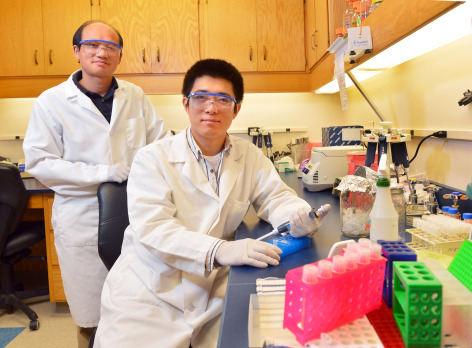
Ganwu Li, left, and Wentong Cai, right, were part of a team of ISU researchers working to identify how E. coli bacteria adapt to the environment found in the kidney and bladder. Larger image. Photo by Robert Elbert.
AMES, Iowa – Researchers at Iowa State University have identified a genetic process by which some Escherichia coli bacteria adapt to the human kidney, a step that could lead to new treatments to stop urinary tract infections.
E. coli, bacteria that usually colonize the intestine, can sometimes cause urinary tract infections when they find their way to the bladder and kidneys – if they can adapt to the new environment. In a new paper this summer, a team of Iowa State researchers showed that uropthogenic E. coli are able to do so by acquiring new traits through a process called two-component signal transduction.
“Bacterial pathogens and their hosts are co-evolving, with both parties engaging in an arms race. In order for E. coli to thrive in an environment beyond the intestine, such as the kidney, they have to adapt,” said Wentong Cai, a graduate assistant in veterinary microbiology and preventive medicine and the first author of the study.
The researchers found that E. coli most likely acquire this adaptive ability by horizontal gene transfer, a process by which organisms exchange genes with neighboring organisms or the environment. They acquire these genes from other organisms that are already present in the urogenital area and have adapted to the environment, said Ganwu Li, a research assistant professor in the ISU College of Veterinary Medicine and the corresponding author of the study.
The researchers found that disruption of the adaptation process greatly reduced the ability of E. coli to cause disease, prompting the researchers to believe their work can lead to novel antimicrobial drugs to contain urinary tract infections, especially pyelonephritis, a serious infection of the kidney.
Cai likened the two-component signaling system to radar. The bacteria must be able to detect the signal that allows them to adapt to the renal environment. By blocking the “antenna of the radar,” or kinase of the signaling system that senses the signal, the bacteria have a much more difficult time colonizing a kidney, he said.
“There are two components to the system,” he said. “One receives the signal, like a radar antenna, while the other transduces the signal to generate a cellular response. We hope we can discover a new molecule that can block the receipt of the signal.”
Li said urinary tract infections account for $1.6 billion in health care spending and 7 million visits to the doctor’s office in the United States every year.
“And between 80 and 90 percent of urinary tract infections are caused by uropathogenic E. coli, so this is a huge problem,” Li said.
The authors of the paper include Lisa K. Nolan, Catherine M. Logue, Yvonne Wannemuehler, Giuseppe Dell’Anna, Bryon Nicholson and Nicolle Barbieri from the ISU College of Veterinary Medicine, plus Yaping Feng from the ISU Laurence H. Baker Center for Bioinformatics and Biological Statistics. The paper was published in the peer-reviewed journal PLoS Pathogens.